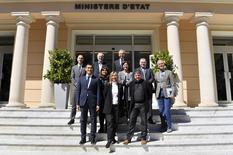- Homepage
- The Environment
- Actualités
- First meeting of the National Committee for Monitoring Marine Protected Areas
First meeting of the National Committee for Monitoring Marine Protected Areas
The first meeting of the National Committee for Monitoring Marine Protected Areas, which is made up of representatives from the Government, the Prince Albert II Foundation, the Institute of Oceanography, Monaco Scientific Centre, the Department of the Environment and the Department of Maritime Affairs, was held on Friday 5 April 2019 at the Ministry of State.
Governance of the Principality’s marine protected areas (MPAs) has been entrusted to the Monitoring Committee, which sets out the major guidelines for managing these areas, an MPA Coordination Group, which aims to facilitate the implementation of these guidelines, and a manager, the Monegasque Association for the Protection of Nature (AMPN), which carries out daily action plans to preserve the environment of MPAs.
The Principality has two marine protected areas:
• The Larvotto marine area, which has been primarily designed to conserve and enhance a patch of Neptune grass and covers a zone between the shore and around 600m out to sea. It has an area of 33.6 hectares, 23 of which are classified as a Ramsar zone, named after the Convention on Wetlands of International Importance.
• The Spélugues coral reef marine area, which is home to coral formations as well as numerous iconic species and habitats (red coral, sponges, hatpin urchins, noble pen shells).
The meeting addressed several issues, such as communication and activities to raise awareness about these spaces, which must be preserved. It is with this in mind that an initial five-year protection and scientific research management plan for these marine areas in the Principality will be set out and implemented by the AMPN.
Autres actualités du thème

H.S.H. Prince Albert II visits the photo exhibition of Responsible Trading and Restaurants in the Principality

The Prince’s Government, the Monaco Port Authority (SEPM) and the Monegasque Sanitation Company (SMA) join forces to protect the marine environment

Memorandum of understanding signed by the Secretariats of the RAMOGE and Pelagos agreements
- The latest news of the Responsible Trading and Responsible Restaurant Certifications
- A guide to banning single-use plastic bags: A bag for life
- Guide to responsible, safe bathing in the Principality
- The Tree Code
- The Environment in the Principality of Monaco – Data Compendium
- Monaco Environment booklet








